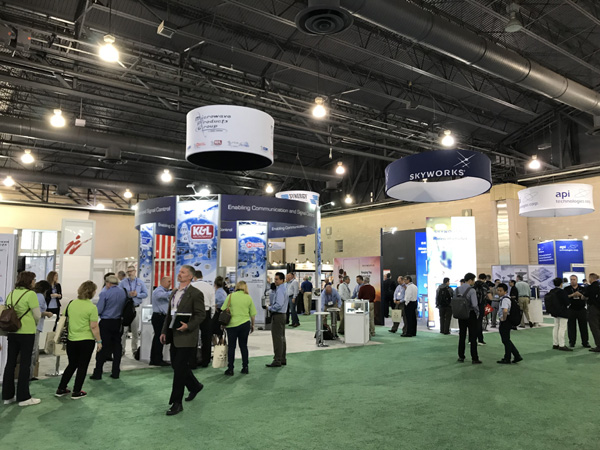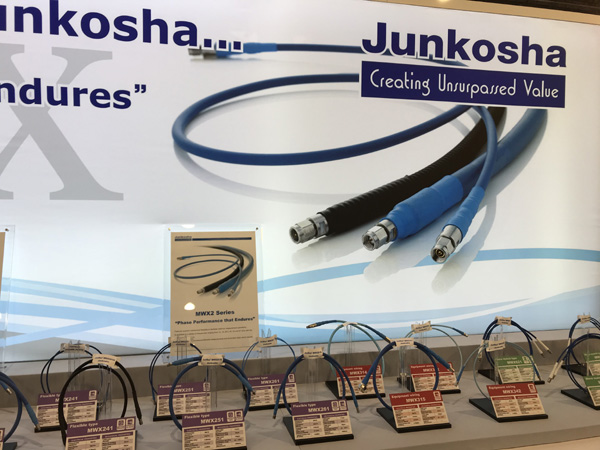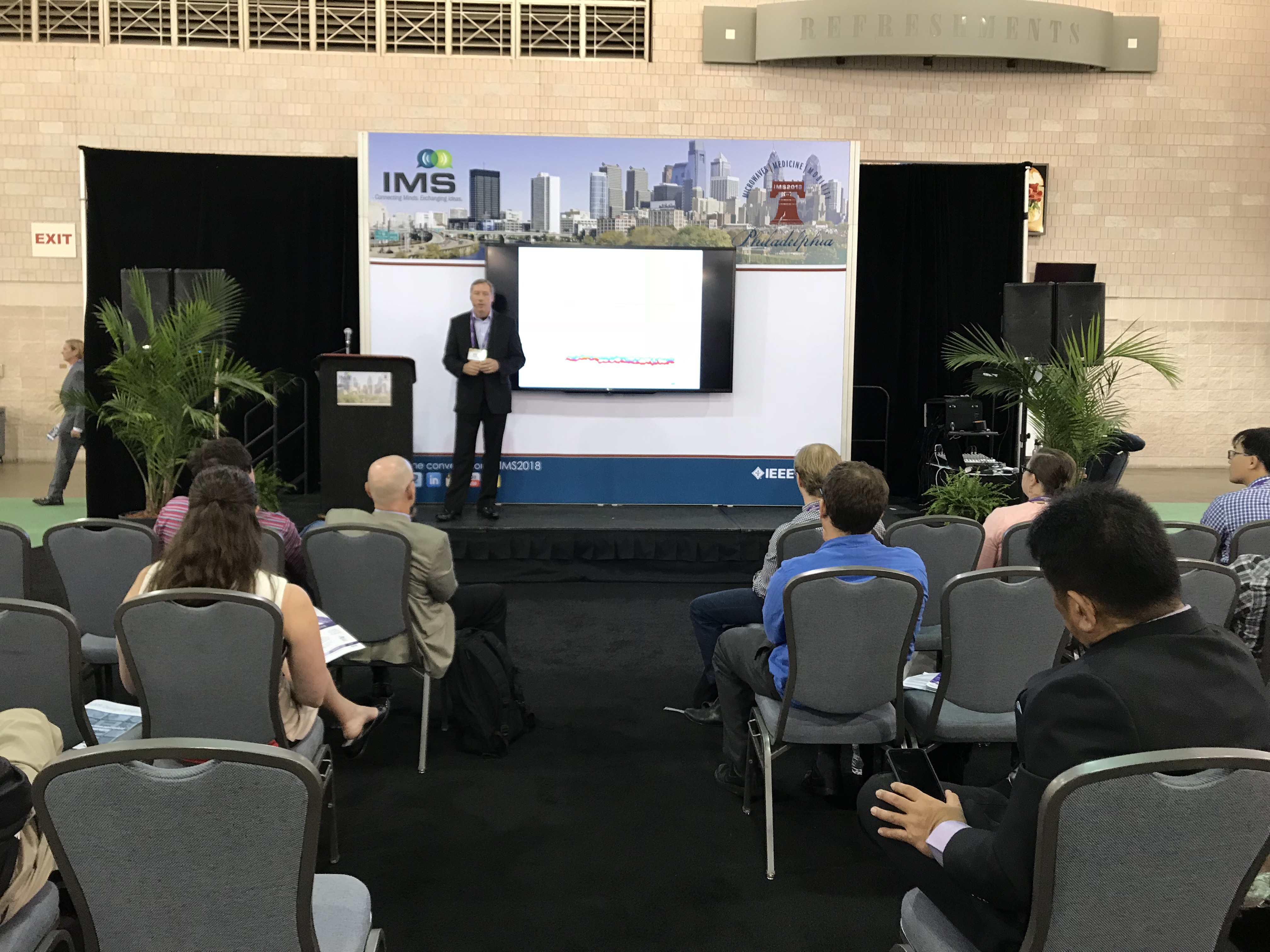While the theme of IMS2018 was Microwaves, Medicine and Mobility, the real theme was 5G, 5G and 5G. Most companies in the exhibition were highlighting their play in the 5G market and with the one day 5G Summit, there were many talks addressing 5G applications and technologies. At the end of the day on Monday, June 11th, the IMS2018 plenary session kicked off with some background on this year’s event, with specifics on the conference and exhibition provided by Afshin Daryoush, Symposium Co-Chair, Sridhar Kanamaluru, Symposium General Chair, and Mohammed Tofighi and Al Katz, Symposium Technical Program Chairs.
 This year’s event included 4 conferences, 600+ exhibitors, 75 technical sessions, and about 840 presentations over 6 days. More than 885 papers were submitted and 425 were accepted, making a 48% acceptance rate. Of the 47 workshops submitted, 33 were accepted. There were papers from 45 countries, with 70% from outside the USA. This year’s IMS included two new events, a panel of physicians and the IMBioC opening session that was held jointly with the IMS closing session.
This year’s event included 4 conferences, 600+ exhibitors, 75 technical sessions, and about 840 presentations over 6 days. More than 885 papers were submitted and 425 were accepted, making a 48% acceptance rate. Of the 47 workshops submitted, 33 were accepted. There were papers from 45 countries, with 70% from outside the USA. This year’s IMS included two new events, a panel of physicians and the IMBioC opening session that was held jointly with the IMS closing session.
The plenary session also took the time to pay a moment of tribute and silence for Tom Brazil, the 2018 MTT-S President who passed away suddenly in April 2018. Then, the attendees were introduced to the first female president of MTT-S, Dr. Dominique Schreurs of the University of Leuven (KU Leuven), Belgium. Schreurs noted that female membership of MTT-S is 5.5%, and she wants to improve that number as well as encourage participation of young professionals during her term. Next, Wolfgang Heinrich, 2018 EuMA President, talked about the close relationship between MTT-S and EuMA (European Microwave Association). He noted that the groups benefit from scientific exchange across borders, and said that “transnational co-operation is a key asset for our community.” The MTT-S EuMA partnership is well established, and EuMA is hosting European Microwave Week in Madrid, Spain the 23rd-28th of September 2018; he encouraged audience members to attend (registration is now open).
The plenary keynote took an interesting journey through the new technologies enabling the delivery of health care. In his talk, Steve Klasko, MD, MBA, and President & CEO of Thomas Jefferson University and Jefferson Health, noted that today’s up and coming healthcare consumers want to access their health care and health history the same way they do banking—which is not at the brick and mortar bank. Klasko shared some of the innovations being done at his facility, generally noting that tele-health leads to increased patient satisfaction. For example, with virtual rounds, doctors and patients can communicate with family members who are not in the building during doctor visits in the hospital room.
Microwave Journal visited as many companies as possible in the exhibition. Here is a summary of the ones we saw (see our photo gallery here):
Cables and Connectors
Carlisle Interconnect Technologies announced the purchase of Tenencia, Ltd., an EASA Part 21 Design and Production organization based in Coventry, United Kingdom. Tenencia specializes in the integration and certification of Electrical / Avionics systems, Cabin systems, internal and external structure, VIP interiors and commercial aerospace applications on a wide range of aircraft. In acquiring Tenencia, CarlisleIT broadens its global capabilities for design certification of commercial aircraft to both EASA and FAA design and production requirements. Paul Johnson and his current team of experts will join the Carlisle team effective June 1st, adding strength to our European capabilities and support to European and global customers.
HUBER+SUHNER made several product announcements around IMS:
- RFEX, the first connector dedicated to RF energy applications, was designed to connect the power amplifier and antenna, handling the high power with minimal loss.
- PSM, a low weight and high power connector series developed for high altitude, space and thermal vacuum environments.
- Spuma RS, a low-loss RF cable encased in a flexible, flame-resistant TPU jacket, well-suited to mobile defense applications.
- SUCOFLEX®526V/526S, a 26.5 GHz phase and amplitude stable cable for test and measurement.
At the DAS & Small Cells Congress in Las Vegas, held at the same time as IMS, HUBER+SUHNER introduced the SENCITY® Occhio antenna for small cells. The antenna covers 1.7 to 6 GHz and is configured for 4 x 4 MIMO.
 Junkosha showcased an ultra-phase stable interconnects that endure in the field and the laboratory. With its next generation MWX051 and MWX061 interconnects, Junkusha has designed mmWave cabling solutions up to 67 GHz to meet the higher frequency demands of tomorrow’s 5G networks. Available with ruggedized NMD connector assemblies to deliver reliable and robust connections to the VNA, these new interconnect solutions have been created to withstand the most rigorous of testing environments for periods of approximately three and a half years. Featuring characteristics including high tensile strength, a low dielectric constant and high flex life due to Junkosha’s precision engineered expanded-PTFE wrapping technology, these new interconnects will test engineers’ resolve to stick with lower quality, lower cost alternatives.
Junkosha showcased an ultra-phase stable interconnects that endure in the field and the laboratory. With its next generation MWX051 and MWX061 interconnects, Junkusha has designed mmWave cabling solutions up to 67 GHz to meet the higher frequency demands of tomorrow’s 5G networks. Available with ruggedized NMD connector assemblies to deliver reliable and robust connections to the VNA, these new interconnect solutions have been created to withstand the most rigorous of testing environments for periods of approximately three and a half years. Featuring characteristics including high tensile strength, a low dielectric constant and high flex life due to Junkosha’s precision engineered expanded-PTFE wrapping technology, these new interconnects will test engineers’ resolve to stick with lower quality, lower cost alternatives.
Formed in 1955, San-tron is a industry veteran connector and cable assembly supplier, with about 70 percent of its products custom. The company’s customers are both military and commercial, with programs ranging from phase-matched cable assemblies for EW jammers to cables for millimeter wave fixed wireless access. At IMS, San-tron featured rugged, high performance cable assemblies for military programs: flexible, weatherproof and dust-proof pressurized assemblies; enhanced TNCs with standard/reverse polarity; high power 7/16 cables; high shock/vibration type N assemblies; and high-flex, 20 GHz eSMA cables.
Telegärtner, a family owned cable and connector company based in Germany, featured new connector products for RF/microwave: the 4.3-10 series covers applications to 16 GHz, and the 2.2-5 series provides a 53 percent size reduction and extends the bandwidth as high as 26 GHz. The series are available with various connection methods: hand screw, wrench tighten and push-pull — all with the same RF performance. With PIM of −166 dBc, Telegärtner’s connectors meet the stringent requirements of wireless infrastructure.
Times Microwave showed off their SilverLine®-VNA 110 GHz that is an armored, extremely high frequency coax cable assembly designed for use where waveguide is impractical. SilverLine®-VNA 110 GHz now offers the user working in these frequencies an alternative to the limited selection of semi-rigid solutions offered by current suppliers. Test technicians experienced in the use and handling of traditional 110 GHz products will find Times’ solution to be more than competitive for RF stability and overall product life.
Velocity Microwave highlighted two interesting products: modular VNA cables and a gage kit able to test 14 connectors. The modular VNA cable design enables the cable assembly to be repaired as elements wear out or are damaged. Velocity guarantees support for the cable assembly for 10 years. Their Galaxy gage kit includes male and female bushings for seven connector types: Type N, SMA pin and dielectric, 3.5 mm, 2.92 mm, 2.4 mm and 1.85 mm. The kit includes a gage with digital readout, for precision measurements.
 W. L. Gore & Associates featured several 5G and aerospace & defense testing insights. Gore introduced GORE® PHASEFLEX® Microwave/RF Test Assemblies, Type 0N – the smallest, lightest, most internally ruggedized assembly on the market today for modular, multi-port, and multi-site test applications to address 5G applications. In the area of defense and aerospace, Gore featured its GORE® PHASEFLEX® Microwave/RF Test Assemblies and their airframe assemblies, GORE-FLIGHTTM Microwave Assemblies, 6 Series. The airframe assemblies are lightweight cable solutions that deliver the lowest insertion loss before and after installation, ensuring reliable performance for the life of an aircraft system. The robust construction reduces total costs by withstanding the challenges of installation, reducing costly production delays, field service frequency, and the need for purchasing replacement assemblies.
W. L. Gore & Associates featured several 5G and aerospace & defense testing insights. Gore introduced GORE® PHASEFLEX® Microwave/RF Test Assemblies, Type 0N – the smallest, lightest, most internally ruggedized assembly on the market today for modular, multi-port, and multi-site test applications to address 5G applications. In the area of defense and aerospace, Gore featured its GORE® PHASEFLEX® Microwave/RF Test Assemblies and their airframe assemblies, GORE-FLIGHTTM Microwave Assemblies, 6 Series. The airframe assemblies are lightweight cable solutions that deliver the lowest insertion loss before and after installation, ensuring reliable performance for the life of an aircraft system. The robust construction reduces total costs by withstanding the challenges of installation, reducing costly production delays, field service frequency, and the need for purchasing replacement assemblies.

